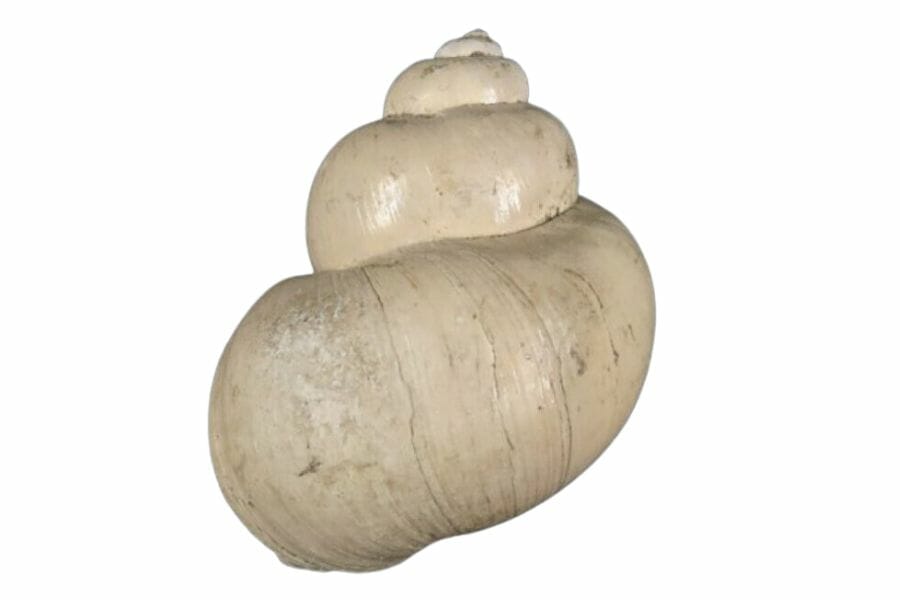Missouri is an exciting place for anyone with a passion for geology and ancient history. The state boasts a rich geological history that’s just waiting to be uncovered but knowing where and how to find Missouri fossils isn’t always easy in such a big state.
We’re going to show you some of the best places to find some incredible fossils around the state and how to be more successful with your hunt. From the Mississippi River along the eastern side to the shared borders with Oklahoma, Kansas, and Nebraska to the west there is a lot of ground to cover.
Missouri fossils offer a glimpse into the world that once was and it’s always more fun when you actually find what you’re looking for!
Whether you’re a seasoned fossil hunter or just getting started, there are many spots across the state where you can try your hand at finding these natural wonders.
Each location provides its own unique set of challenges and rewards. With the right tools, patience, and a keen eye, you could uncover remnants from a bygone era.
The Fossils Of Missouri You Can Find
From trilobites that once roamed the ocean floors to giant mastodon bones, Missouri has a rich history captured in stone.
If you’re interested in more than just fossils, our guide to rockhounding in Missouri can help you out. It’ll point you to spots where you can find special rocks, minerals, and gems across the state.
- The extensive local experience and understanding of our team
- Input from multiple local fossil hunters and fossil groups
- The accessibility of the various locations
- Safety and potential hazards when collecting
- Private and public locations
- A desire to include locations for both experienced fossil lovers and those who are just starting out
Using these weights we think we’ve put together the best list out there for those who love finding great new fossils for our collections!
Common Missouri Fossils
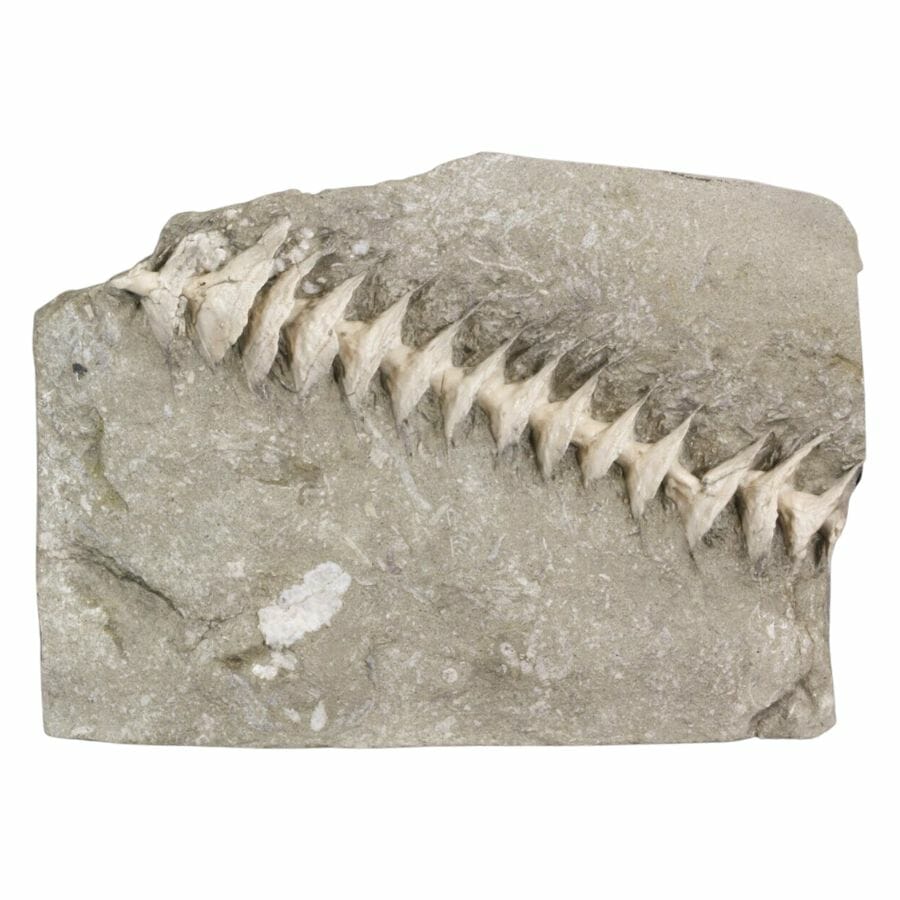
Here is a list of common fossils you might come across in the Show-Me State!
- Archimedes
- Brachiopods
- Cephalopods
- Conodonts
- Corals
- Crinoids
- Armored fish
- Trilobites
- Pelecypods
- Bryozoa
- Gastropods
Missouri State Fossil – Crinoids
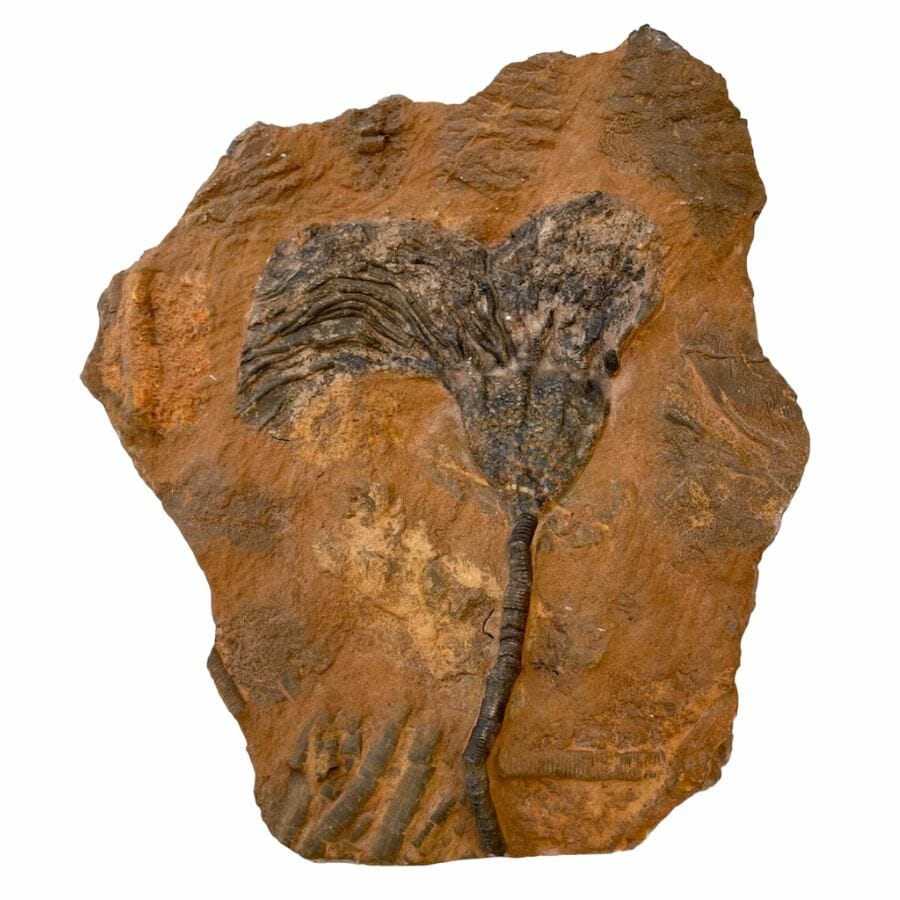
Crinoids are fascinating marine animals that look a bit like underwater flowers. They have a long stem that anchors them to the ocean floor and feathery arms that they use to catch tiny bits of food from the water.
Even though they seem like plants, they’re actually related to starfish and sea urchins. Some crinoids have been around for millions of years, leaving behind fossils for us to discover and study today!
Rare Missouri Fossils
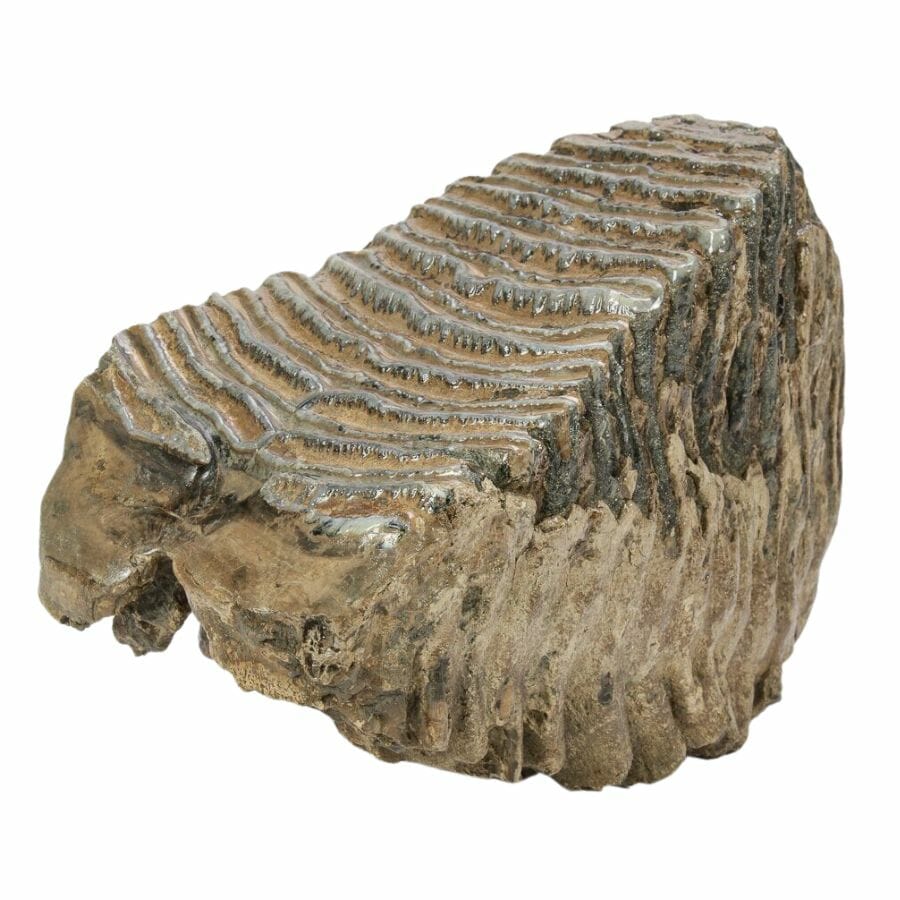
For those with a keen eye and a sense of adventure, there’s a chance to stumble upon valuable rare Missouri fossils. Let’s explore some of these uncommon finds you might encounter in the Show-Me State!
- Dinosaur bones
- Mammoth bones
- Other reptile and mammal bones
The Best Places To Find Fossils In Missouri
As you explore different areas of the state, you’ll find spots that are especially known for their fossils. These locations offer a window into the fascinating past, revealing stories of creatures from long ago. Take a look at our top five picks.
Always Confirm Access and Collection Rules!
Before heading out to any of the locations on our list you need to confirm access requirements and collection rules for both public and private locations.
These requirements are subject to change without notice and may differ from what we state below.
Always get updated information directly from the source ahead of time to ensure responsible rockhounding.
Finger Lakes State Park
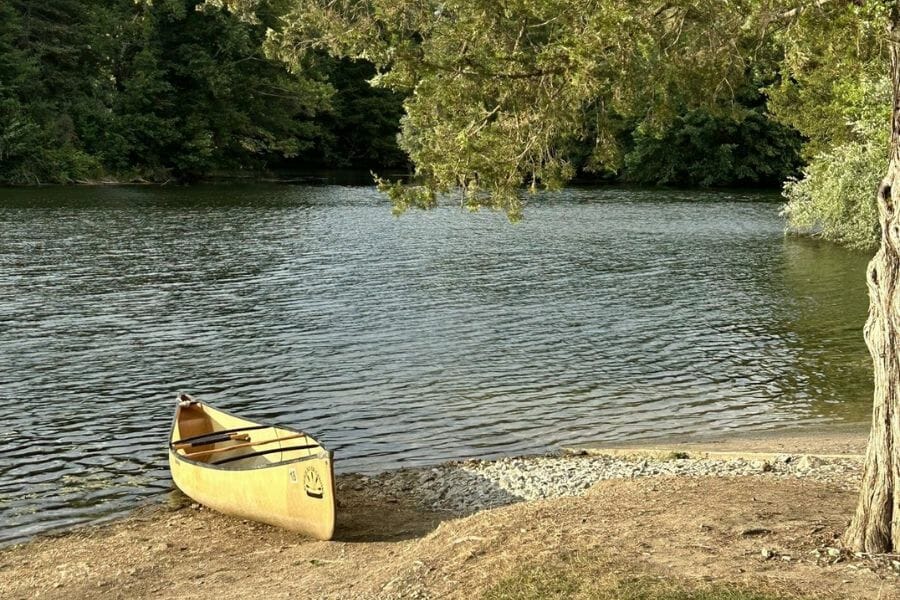
Finger Lakes State Park is a unique spot that offers a mix of fun activities and amazing geology. The park was once a coal mining area, and the remains of this history have now filled with water to create a series of beautiful lakes.
These lakes, with their sparkling blue waters, are the heart of the park and are perfect for water activities. The terrain around them is varied, with wooded areas, hills, and open spaces.
The geology of the area tells a captivating story, especially for fossil hunters. Among the rocks and sediment, you might find fossils in Missouri that give hints about the creatures that lived here long ago.
Additionally, the park’s trails are great for both beginners and experienced hikers, offering various viewpoints of the lakes and the land’s geological features.
The Finger Lakes State Park is easily accessible by main roads. Once you arrive, there’s plenty of parking and facilities to make your visit comfortable and enjoyable.
Whether you’re into boating, hiking, or just exploring, this park has something special to offer.
Where to find fossils in Finger Lakes State Park
Among the sediment and rock, one can find plant fossils, especially fern impressions that give us clues about the vegetation from long ago. These fossils are often found on the sides of the trails or near the water’s edge.
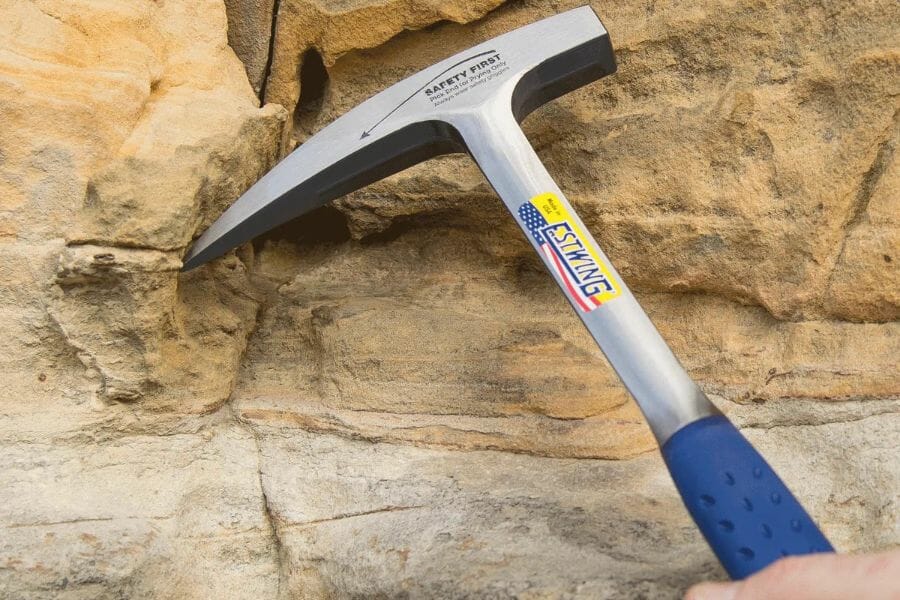
The tools every fossil hunter will need
When you're out looking for fossils having the right tools for the job is really going to make or break your success. You don't need a lot for most trips but there are a handful that are critical and will make your life a lot easier.
We get asked a lot about the equipment we use. Over the years we've found a handful of tools that we recommend to both new and experienced fossil hunters which we outline in great detail in our complete rockhounding tools and kit guide. These are quality options that also happen to be relatively inexpensive.
Below are the basic tools that make your life so much easier and save you a ton of time. Check out the full guide to see everything we recommend bringing. One quick note, as an Amazon Associate I earn from qualifying purchases but we try very hard to only recommend gear we would use ourselves and often recommend brands you can't find on Amazon.
At a minimum you should have:
1 - Sturdy rock hammer: The Estwing Rock Pick is our standard
2 - Rugged chisels: Try Kendo' 3-piece Chisel Set
3 - Compact shovel: The Koleiya 28-inch shovel works well
4 - Rock screen pan: The Wazakura Soil Sieve Set fits the bill
5 - Eye protection: DeWalt Safety Glasses are cheap and comfortable
6 - Head protection: Malta's Safety Helmet has been our go-to
7 - Jewelers lens with at least 20x magnification: Jarlink's Jewelers Loop is perfect
The fossil-finding books that we use most
There are also a few books that have been extremely helpful in the search for gems. These books have great recommendations and tips:
National Audubon Society Field Guide to Rocks and Minerals: North America
Northwest Treasure Hunter's Gem & Mineral Guide
Earth Treasures: The Northwestern Quadrant
We provide links to find these tools on Amazon but some can also be found at your local hardware stores. For more recommendations check out the link to our full tool guide above.
Capen Park
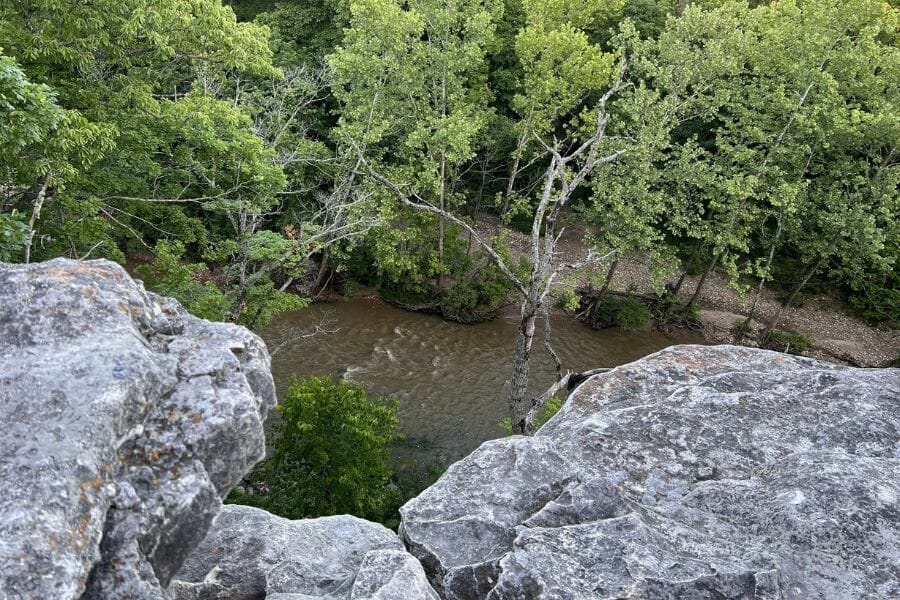
Capen Park is a captivating spot nestled among lush greenery and striking rock formations. It’s predominantly known for its unique bluffs made of limestone, which tower over the area and attract rock climbers of various skill levels.
These bluffs not only provide a playground for adventure-seekers but also tell a geological story of the land from many years ago.
As you explore, you might spot different layers in the rock, showing evidence of the various environmental changes the area has undergone.
The terrain of the park is a blend of these rocky cliffs, wooded trails, and serene spots perfect for picnics or relaxation.
Hiking enthusiasts will love the trails that weave through the park, offering beautiful views of the surroundings and the occasional glimpse of local wildlife.
Major roads lead to the park’s entrance, and clear signage ensures that even first-time visitors can locate it with ease.
Once there, parking and facilities are available. It’s thus convenient for families, solo travelers, or groups to spend the day exploring and enjoying the beauty of nature.
Where to find fossils in Capen Park
Within these rock layers, enthusiasts can discover plant fossils and occasionally marine fossils, indicating a time when waters covered the land.
Fossil hunting in Missouri, especially in areas like Capen Park, often leads explorers to the base of cliffs and creek beds.
Riverbluff Cave
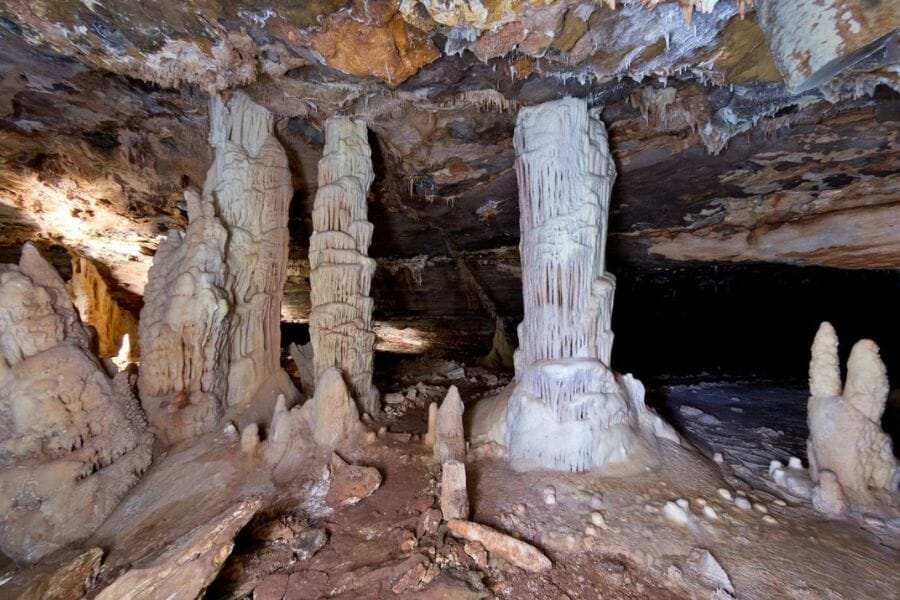
Riverbluff Cave is an underground wonder that captivates both seasoned explorers and curious visitors.
This vast cave system showcases spectacular rock formations like stalactites, stalagmites, and flowstones that have been shaped over countless years by dripping water.
Each formation inside the cave tells a tale of the minerals present and the passage of time.
The terrain inside Riverbluff Cave is a blend of smooth pathways, uneven ground, and narrow passages. Visitors need to be cautious and wear suitable footwear to navigate safely.
Clear road signs point the way to Riverbluff Cave, ensuring that even newcomers find their path effortlessly. Once there, a spacious parking area welcomes visitors, and the entrance to the cave is clearly marked.
Where to find fossils in Riverbluff Cave
Inside Riverbluff Cave, one can find evidence of creatures that once lived in the area. Among the common Missouri fossils, explorers have spotted bear and other mammal bones embedded in the cave’s walls and floors.
These fossils are typically found in the deeper and less trafficked sections of the cave, preserved for countless years.
Missouri River
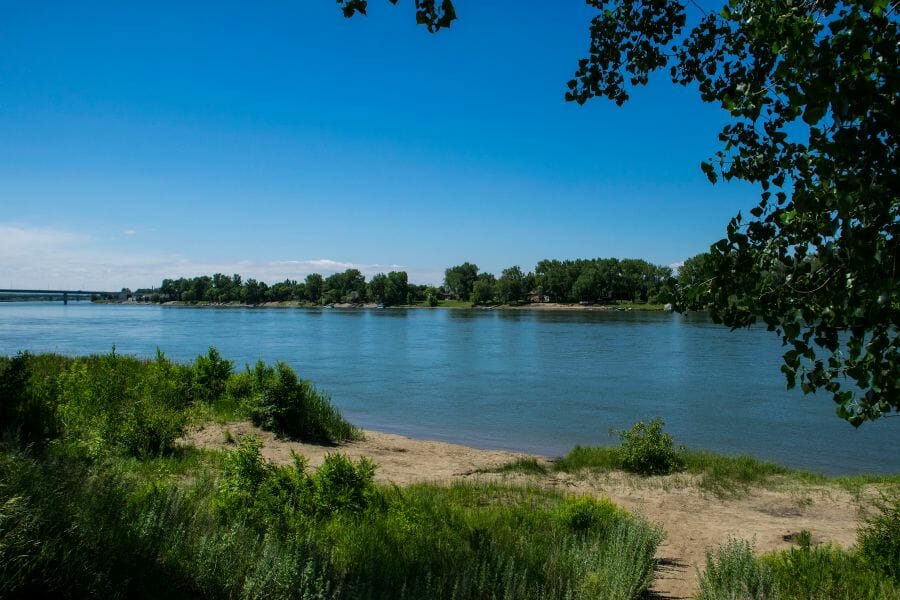
The Missouri River is one of North America’s longest rivers, winding its way through vast landscapes.
Geographically, it cuts through diverse regions, ranging from rolling hills to wide-open plains, and serves as a vital water source for many communities and ecosystems along its banks.
Geologically speaking, the river’s path reveals layers of sedimentary rock and various deposits that narrate the land’s history over millions of years.
The terrain around the river varies, with some areas featuring tall bluffs overlooking the water, while other stretches are lined with lush forests and green spaces.
The Missouri River is easy to get to. Major roads and highways often run parallel to or cross the river, making it easily accessible for those wishing to fish, boat, or simply enjoy the scenic beauty.
The river’s banks and parks offer numerous spots for families and individuals to relax, take in the view, or engage in fun outdoor activities.
Where to find fossils in the Missouri River
In various spots along the river, particularly near eroded riverbanks or exposed sediment layers, enthusiasts can uncover fossils of fish and small aquatic creatures.
Additionally, the areas where tributaries join the main river often reveal sediment deposits rich with plant fossils.
St. Louis County

St. Louis County boasts a rich tapestry of landscapes, from urban sprawls to serene natural settings. Geographically, the county is characterized by a mix of flat plains and gentle hills, offering diverse scenery for locals and visitors alike.
Its geology is captivating, with sedimentary rock layers revealing stories of the past, including the fascinating fossils of Missouri.
The terrain features lush forests in some areas, intermixed with bustling neighborhoods and commercial zones. Streams and rivers meander through the county, providing a scenic backdrop for various outdoor activities.
You can reach St. Louis County via a network of roads and highways. Both public transportation options and well-maintained roadways ensure that reaching any part of the county is a hassle-free experience for travelers
Where to find fossils in St Louis County
Many of the county’s parks and natural areas have sedimentary rock outcroppings where enthusiasts might discover traces of plants and small aquatic creatures.
Creek beds and riverbanks, where erosion exposes older layers, are particularly good spots to look in.
Other Top Places To Find Missouri Fossils By Region
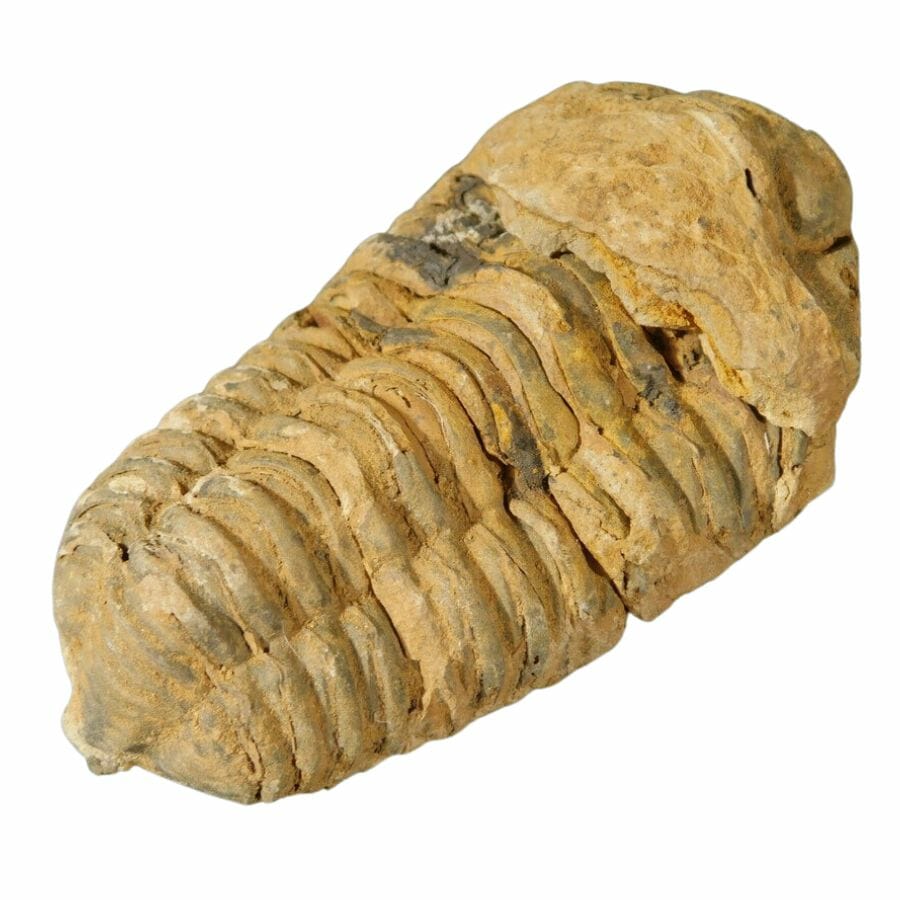
Here are more areas where you can look for fossils across the state.
| Location | Fossils |
| Cassville, Barry County | Bryozoa, brachiopods, pelecypods, gastropods, corals |
| Flat Creek, Barry County | Corals, blastoids, crinoids, echinoids, bryozoa, brachiopods, pelecypods, gastropods, trilobites, fish, conodonts |
| Washburn, Barry County | Corals, blastoids, brachiopods, pelecypods, gastropods, trilobites |
| Crooked Creek Township, Bollinger County | Ray teeth, turtle bones |
| Columbia, Boone County | Brachiopods, corals, sponges |
| Easley, Boone County | Spirifer, Chonetes, Productus, crinoids, brachiopods, bryozoa, crinoids, pelecypods, worms, corals, gastropods, cephalopods, blastoids, trilobites, fish, conodonts, ostracods, sponges |
| Buchanan County regional exposures | Brachiopods, pelecypods, gastropods |
| St Joseph, Buchanan County | Brachiopods |
| Booneville, Callaway County | Lepidodendron, Sigillaria, rare crinoid crowns |
| Cow Creek, Callaway County | Brachiopods, bryozoa, pelecypods, corals, crinoids |
| Williamsburg, Callaway County | Brachiopods, corals, crinoid fragments, pelecypods, gastropods, Ptyctodus |
| Trail of Tears State Park, Cape Girardeau County | Trilobites, cephalopods |
| Harrisonville, Cass County | Pelecypods |
| Pleasant Hill, Cass County | Brachiopods Orbiculoidea |
| Kansas City, Clay County | Crinoids |
| Clinton County, Clinton County | Phillipsia |
| Jefferson City, Cole County | Brachiopods, corals, trilobites |
| Clifton City, Cooper County | Crinoids, brachiopods, cephalopods, fish bones and teeth, corals, pelecypods, trilobites, worms |
| Ash Grove, Greene County | Spirifer, Chonetes, Productus, crinoids, brachiopods |
| King Butte, Greene County | Brachiopods, Pelecypods, gastropod molds, cephalopods, trilobites |
| Springfield, Greene County | Corals, bryozoa, bear, turtles, pigs, snakes, diverse fauna |
| Bethany, Harrison County | Fasciculiconcha |
| Lucas, Henry County | Edestid shark teeth |
| Montrose, Henry County | Crossopterygian fish scales Rhizodopsis |
| Hamburg, Jefferson County | Sponges, corals, graptolites, cystoids, crinoids, bryozoa, brachiopods, pelecypods, cephalopods, trilobites |
| Plattin Creek, Jefferson County | Silicified plants, graptolites, sponges, corals, crinoids, annelids, bryozoa, brachiopods, pelecypods, gastropods, cephalopods, trilobites, crustacea, ostracods, conodonts |
| Sulphur Springs, Jefferson County | Ptyctodus teeth, brachiopods |
| Knobnoster, Johnson County | Brachiopods |
| Moscow Mills, Lincoln County | Crinoids Pustula, Rhipidomella, brachiopods, bryozoa, blastoids |
| Fredricktown, Madison County | Diverse trilobites |
| St Francois Mountains, Madison County | Trilobites, brachiopods, mollusks, corals, crinoids, gastropods |
| Tipton, Moniteau County | Blastoids, echinoids, corals, gastropods, worm tubes |
| Montgomery City, Montgomery County | Rhipidomella, Cyrtina, Syringothyris, pelecypods, trilobites, Paryphorhynchus |
| Udall, Ozark County | Sponges, trilobites, cephalopods |
| Lithium, Perry County | Chester fauna, pelecypods, gastropods |
| Mystery Cave, Perry County | Elephant bone |
| Sedalia, Pettis County | Coral Chaetetes, Spirifer, Chonetes, Productus, crinoids, brachiopods |
| Rolla, Phelps County | Mollusks Straparolus, trilobites |
| Clarksville, Pike County | Large brachiopod beds |
| Large brachiopod beds | Corals, crinoids, brachiopods, pelecypods, gastropods, cephalopods, trilobites |
| Weston, Platte County | Brachiopods Beecheria |
| Rensselaer, Ralls County | Crinoids, bryozoa |
| Saverton, Ralls County | Sponges, corals, annelids, blastoids, crinoids, fish |
| Eminence, Shannon County | Mollusks, trilobites, Taeniospira, Plethopeltis, trilobites, gastropods |
| Grassy Creek, Shannon County | Ophileta, Ozarkina, Cameroceras, Clarkoceras, Euomphalopsis, Chepultapecia |
| Clarksville, St. Charles County | Trilobites |
| Bonneterre, St. Francois County | Trilobites, Coosia, Crepicephalus |
| Flat River, St. Francois County | Brachiopods Eoorthis |
| Establishment Creek, St. Genevieve County | Spirifer, Chonetes, Productus, crinoids, brachiopods |
| Little Saline Creek, St. Genevieve County | Sponges, corals, cystoids, blastoids, crinoids, bryozoa, brachiopods, pelecypods, gastropods, trilobites |
| White Sound, St. Genevieve County | Bryozoa, brachiopods, pelecypods, gastropods |
Common Questions About Fossil Hunting In Missouri
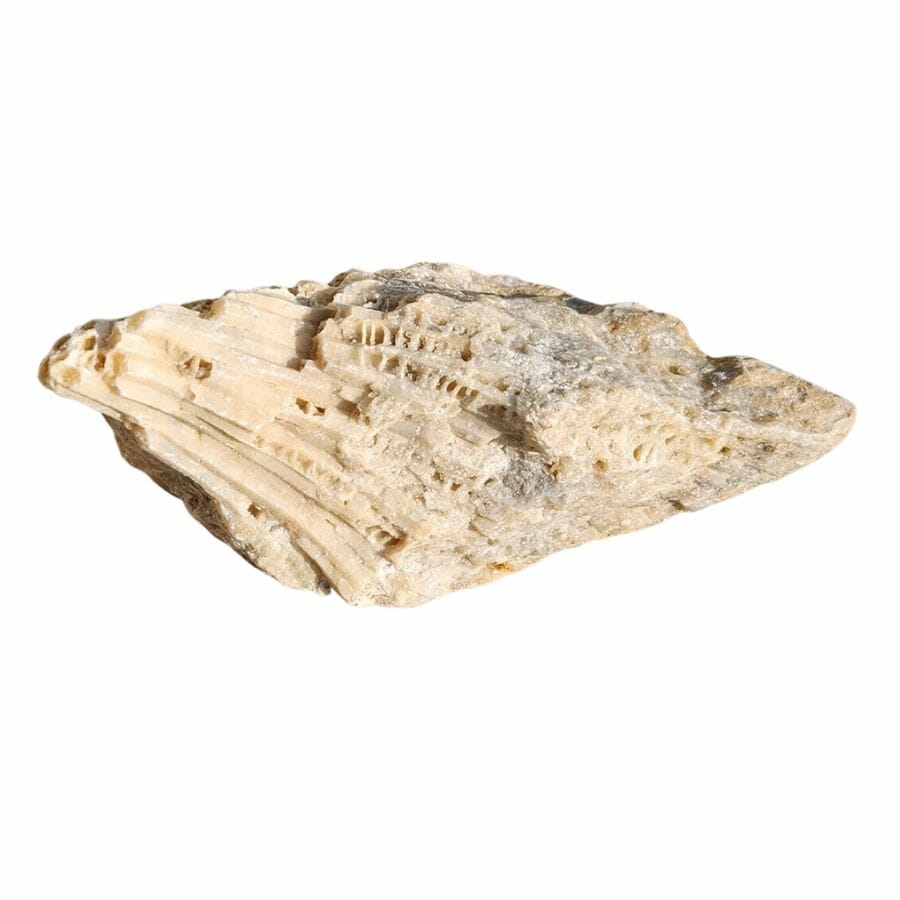
From understanding what fossils are to knowing where they can be found, there’s a lot to learn. Dive in to find answers to the most common questions about Missouri’s fossil treasures!
Can you find megalodon teeth or shark teeth in Missouri?
Finding megalodon teeth in Missouri is unlikely. The megalodon was a giant shark that lived millions of years ago, and its range was mostly in the oceanic areas where it had ample food.
Because of this, the chances of stumbling upon a megalodon tooth in Missouri are slim. You’ll have more luck in coastal areas.
On the other hand, smaller shark teeth from other species are definitely present in Missouri’s sedimentary rocks, especially in areas that were once underwater.
Missouri was once covered by vast seas, making it a place where you can find fossilized remains of marine life.
When you’re looking for shark teeth, it’s a good idea to focus on stream beds, river banks, and areas with exposed rocks. These teeth are often small, so you’ll need to have a keen eye.
Is it illegal to collect fossils in Missouri?
In Missouri, the rules for collecting fossils vary based on the land’s ownership. Fossil hunting in Missouri on public lands, like state parks, can be restricted.
It’s essential to always check with the Missouri Department of Natural Resources before removing any fossils. On private property, you can collect fossils with the landowner’s permission.
Always make sure to get this permission in writing to avoid any misunderstandings.
If you’re passionate about collecting, joining a local rock and fossil club can offer guidance, and members often share spots where collecting is permitted.
Respect the land, its history, and its rules, and you’ll have a rewarding experience while ensuring these treasures remain for others to enjoy in the future.
Can you find dinosaur bones in Missouri?
Most of the rocks in Missouri are older than the time of dinosaurs. So, finding dinosaur bones in Missouri can be a bit tricky. While complete dinosaur skeletons are rare, there have been a few isolated finds.
Most discoveries in the state are from the latter part of the Paleozoic Era, which predates the time of the dinosaurs. Instead, the fossils commonly found here are of marine animals, plants, and other pre-dinosaur creatures.
For those eager to see dino bones, local museums might be the best bet as they showcase specimens from other regions.
How do you identify the fossils that you find?
Identifying fossils can be a fun and exciting challenge! The first step is to observe the shape, size, and texture. Some fossils might look like shells, while others resemble plant leaves or bones.
Using a magnifying glass can also give you a closer look at small details.
When you think about the fossils of Missouri, for example, you’ll often find traces of marine animals due to the state’s geologic history. You can expect fossils here to look like shells, corals, snails, and the like.
A good field guide or fossil book is a handy tool to have. These guides have pictures and descriptions that can help match your find with known fossils.
Joining a local rock and fossil club can be super helpful. Experienced members can offer guidance and share their knowledge. Plus, it’s always more fun to learn with others!
Whatever you find, documenting the location and taking notes will help in future identifications.
Our Favorite Places To Buy Fossils In Missouri
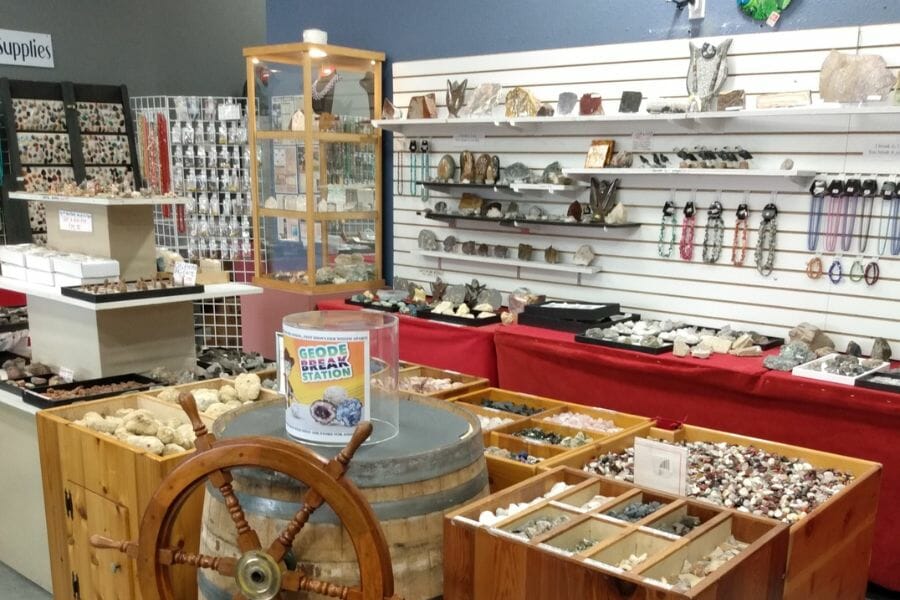
If you’re looking to buy a few incredible fossils, there are several top-notch spots across the state. You’re sure to find the perfect fossil to add to your collection in the local shops below.
- Prehistoric Fossils – 101 Veterans Blvd, Branson, MO 65616
- Prospectors Crystals, Rocks & Gift Shop – 1640 Gravois Rd, High Ridge, MO 63049
- Peggy’s Rock Shop – 3705 State Hwy 76, Branson, MO 65616
- Fall Creek Rock Shop – 11010 Dillon Outer Rd, Rolla, MO 65401
- STL Rocks – 2003 Cherokee St, St. Louis, MO 63118

